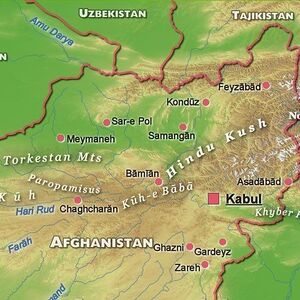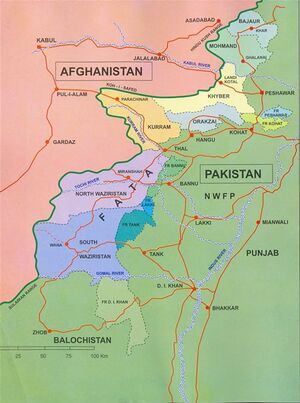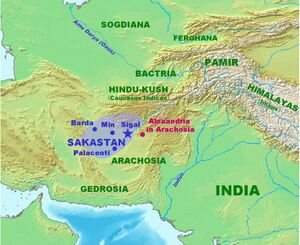Hindu-Kush
| Author:Laxman Burdak, IFS (R) |




Hindu Kush (हिन्दूकुश) is an 800 km long mountain range that stretches between central Afghanistan and northern Pakistan.
Variants of name
- Hindu-Koosh (Anabasis by Arrian, p. 197, 202, 263.)
- Caucasus Indicus
- Hindukush
- Hindu-Koosh
- Lohitagiri /Lohitāgiri (लोहिता गिरि) (old name of Hindukush)[1]
- Rohitagiri (रोहित गिरि) [2]
- Paropamisadae (by Greeks)
- Paropanisus
- Tusharagiri (तुषारगिरि) (Mahabharata (VI.10.66)
- Paropauisidæ (Pliny.vi.23)
- Paropamisadae (Megasthenes)
- Paropanisadai
- Paropanisadae
Origins of the name
The origins of the name "Hindu Kush" are uncertain, with multiple theories being propounded by different scholars and writers. Hindu Kūh (ھندوکوه) and Kūh-e Hind (کوهِ ھند) are usually applied to the entire range separating the basins of the Kabul and Helmand rivers from that of the Amu River (ancient Oxus) or more specifically to that part of the range, northwest of the Afghan capital Kabul. Sanskrit documents refer to the Hindu Kush as Pāriyātra Parvata (पारियात्र पर्वत).
The mountain range was called "Paropamisadae" by Greeks in the late first millennium BC. In the time of Alexander the Great, they were further referred to as the Caucasus Indicus or "Indian Caucasus", which past authors have additionally considered as a possible derivation of the name "Hindu Kush".
The highest point in the Hindu Kush is Tirich Mir (7,708 m or 25,289 ft) in Chitral District of Khyber Pakhtunkhwa, Pakistan.
Mention by Pliny
Pliny[3] mentions The Indus...The greater part of the geographers, in fact, do not look upon India as bounded by the river Indus, but add to it the four Satrapies of the Gedrosi,13 the Arachotæ,14 the Arii,15 and the Paropauisidæ,16 the river Cophes17 thus forming the extreme boundary of India. All these territories, however, according to other writers, are reckoned as belonging to the country of the Arii. (21.)
13 Gedrosia comprehended probably the same district as is now known by the name of Mekran, or, according to some, the whole of modern Beloochistan.
14 The people of the city and district of Arachotus, the capital of Arachosia. M. Court has identified some ruins on the Argasan river, near Kandahar, on the road to Shikarpur, with those of Arachotus; but Professor Wilson considers them to be too much to the south-east. Colonel Rawlinson thinks they are those to be seen at a place called Ulan Robat. He states that the most ancient name of the city, Cophen, (mentioned by Pliny in c. 25 of the present Book), has given rise to the territorial designation. See p. 57.
15 The people of Aria, consisting of the eastern part of Khorassan, and the western and north-western part of Afghanistan. This was one of the most important of the eastern provinces or satrapies of the Persian empire.
16 This was the collective name of several peoples dwelling on the southern slopes of the Hindoo Koosh, and of the country which they inhabited which was not known by any other name. It corresponded to the eastern part of modern Afghanistan and the portion of the Punjaub lying to the west of the Indus.
17 It is supposed that the Cophes is represented by the modern river of Kabul.
Jat clans mentioned by Megasthenes
Megasthenes also described India's caste system and a number of clans out of these some have been identified with Jat clans by the Jat historians. Megasthenes has mentioned a large number of Jat clans. It seems that the Greeks added 'i' to names which had an 'i' ending. Identified probable Jat clans have been provided with active link within brackets. (See Jat clans mentioned by Megasthenes)
| Jat clans as described by Megasthenes | ||||||||||||
| Location | Jat clans | Information | ||||||||||
|---|---|---|---|---|---|---|---|---|---|---|---|---|
| 24. Beyond Indus
|
Four satrapies, --the Gedrosi (Gadar), Arachotae (Arak), Arii (Aria, Herat), Paropamisadae (Kabul valley)
|
Making the river Cophes (Kabul) its furthest limit; though others prefer to consider all these as belonging to the Arii (Aria) | ||||||||||
हिन्दूकुश
हिन्दूकुश - इस पर्वत का नाम महाभारतकाल में तुषारगिरि था जो कि इस क्षेत्र पर तुषार गोत्र के जाटों का शासन होने से उनके नाम पर ‘तुषारगिरि’ कहा गया। बाद में मुसलमानों के समय में इस पर्वत का नाम हिन्दुकुश पड़ गया, जिसका ब्यौरा निम्नलिखित है -
हिन्दुकुश अपभ्रंश है इन्दुकुश का। इन्दु चन्द्रमा और कुश = मारना, अर्थात् जहां पर चन्द्रवंशीय श्रीकृष्ण जी के वंशज महाराज सुबाहु, रिझ, गज, शालिवाहन और बलंद ने मुसलमानों से भीषण युद्ध किये थे, इसीलिए उस देश के पहाड़ों की पंक्ति को इन्दुकुश या हिन्दुकुश कहते हैं।[4]
Mention by Panini
Lohitagiri (लोहित गिरि) is name of a Mountain mentioned by Panini. [5]
Rohitagiri (रोहितगिरि) is mentioned by Panini in Ashtadhyayi. [6]
Rohitagiriyas (रोहितगिरीयस), a mountainous tribe, is mentioned by Panini in Ashtadhyayi. [7]
Lohitagiri (लोहितागिरि), Hindukush (हिंदुकुष), is mentioned by Panini in Ashtadhyayi. [8]
Mention by Pliny
Pliny[9] mentions 'The Indus'....The Indus, called Sindis by the natives, rises in that branch of the Caucasian range which bears the name of Paropanisus,1 and runs in an easterly direction, receiving in its course the waters of nineteen rivers. The most famous of these are the Hydaspes,2 into which four other rivers have already discharged themselves, the Cantaba,3 which receives three other rivers, the Acesinus, and the Hypasis,4 which last two are navigable themselves.
1 Or Hindoo Koosh. In this statement he is supported by Arrian, Strabo, Mela, and Quintus Curtius. It rises, however, a considerable distance on the north-east side of the Himalaya.
2 The modern Jhelum.
3 Some writers suppose that this must be the same as the Hydraotes, or modern Ravi River, because the latter is not otherwise found mentioned in the list given by Pliny. The name, however, leaves but little doubt that Pliny had heard of the Acesines under its Indian name of Chandabragha, and out of it has made another river.
4 The modern Sutlej.
History
V S Agarwal [10] writes about Mountaineer Sanghas – A very important group of martial Sanghas comprised those occupying some parvata or mountainous region in north-west India.
[p.435] Evidently this parvata region must have been outside the plains of the Vahika Country, which brings us to the highlands of north-west as the homeland of the ayudhajivins. The Kashika mentions Hrdgoliyas Hridgola, probably Hi-lo of Yuan Chwang (modern Hidda south of Jalalabad); Andhakavartīyāḥ of Andhakavarta, perhaps Andkhui, a district in the north-east Afghanistan and Rohitagiriyas of Rohitagiri, which last is important as reminiscent of Roha, old name of Afghanistan. All this portion of the country is up to the present day peopled by hardy and warlike Mountaineers.The Markandeya Purana refers to mountain-dwellers of the west, including such names as Nihāras (Nigrahāra of Vayu, same as Nagarahāra or Jalalabad where Hṛidgola or Hiḍḍā is situated) and the Haṁsamārgas (modern Hunza in the north of Dardistan). Thus country of mountaineers extended from Kashmir to Afghanistan and most of the people settled in these mountains and their valleys were of the Ayudhajivin class. The Bhishmaparva specially mentions Girigahvaras (गिरिगह्वर) (VI.10.66), dwellers of mountain caves, as a people of the north-west (Bhishmaparva, 9.68, Udyogaparva, 30.24), and this epithet appropriately applies to the tribes of the north-west. They were the same as Sanghah girichāriṇaḥ and girigahvara-vasinah (Dronaparva, 93.48).
Arrian mentions these mountainous Indians as fighting in the army of Darius against Alexander at Arbela (Anabasis, III,8.3-6). It was these Parvatiya Ayudhajivin that offered stout resistance to Alexander in Bactria and Gandhara.
The approximate location of these Parvatiyas should be sought for in the region of the Hindukush on both sides of it. Roha, of medieval geographers, Rohitagiri of Panini, the ten Mandalas of Lohita (Sabhaparva, 24.16) and Rohitagiriyas of Kashika, all together point to the mountainous regions of the central and north-east Afghanistan as being the Parvata Country, which name survives in Kohistan.
Alexander the Great explored the Afghan areas between Bactria and the Indus River after his conquest of the Achaemenid Empire in 330 BC. It became part of the Seleucid Empire before falling to the Indian Maurya Empire around 305 BC.
Alexander took these away from the Persians and established settlements of his own, but Seleucus Nicator gave them to Sandrocottus (Chandragupta), upon terms of intermarriage and of receiving in exchange 500 elephants.[11] ( —Strabo, 64 BC–24 AD)
Indo-Scythians expelled the Indo-Greeks by the mid 1st century BC, but lost the area to the Kushan Empire about 100 years later.[12]
Before the Christian era, and afterwards, there was an intimate connection between the Kabul Valley and India. All the passes of the Hindu-Kush descend into that valley; and travellers from the north as soon as they crossed the watershed, found a civilization and religion, the same as that much prevailed in India. The great range was the boundary in those days and barrier that was at time impassable. Hindu-Kuh--the mountain of Hind--was similarly derived.
Buddha Prakash[13] mentions.... [p.104]: Foremost among the tribes, who took up the struggle against the Saka-Kushanas, were the Yaudheyas. They were akin to the Iranian tribe Yautiya, who figured in the volkerwanderung
[p.105]: of peoples which brought the Medes and Persians into Iran about the 9th-8th century B. C. Driven forward by the Medes, these people bifurcated into two wings, the right one pushing north-west- wards up to Transcaspiana and the left one wheeling towards the south-east and penetrating into the Panjab. In the sixth century B. C. their chief Vahyazdata posed a challenge before the Achaemenian emperor Darius by capturing the Kabul Valley, but was defeated by the governor of Harahvatis, Vivana.
Along with the Yautiya the warrior clans of the Hindukush region, called ‘the ten mandalas of Lohita’ in the Mahabharata (II, 27, 17) and Rohitagiriya in the Kashika (IV, 3, 91), who gave their name Roh to medieval Afghanistan, also seem to have moved cast. The name of the township of Rohitaka or Rohtak in Hariyana appears to enshrine a reminiscence of their settlement. The name of a Jat gotra Rohila also suggests that these people are connected with the ancient Rohitas or Rohs who had come to East Panjab. Subsequently they moved into Rajasthana where we come across the name Rohilladdhi in the Jodhpur inscription of Bauka. In medieval times they settled in the Transgangetic region of Uttar Pradesha which came to be known as Rohilkhand after them. That the Rohitas (Ruhilas of medieval times) moved with the Yautiya becomes clear from the existence of the settlements of both of them in the same region of Hariyana.
Pre-Islamic populations
Pre-Islamic populations of the Hindu Kush included Shins, Yeshkun, Chiliss, Neemchas, Koli, Palus, Gaware, Krammins, Indo-Scythians, Bactrian Greeks, Kushans.
In Ramayana
In Kishkindha Kanda Sarga 42 (Ramayana) Sugreeva sends troops to west side to search for Sita under the leadership of Sushena, the father of lady Tara. Describing the various provinces like Surashtra, Balhika and Chandrachitra (Mathura), Western Ocean, River Sindhu and magnificent mountains including Pariyatra that are situated at the northwest of India, cities like Murachi, Jatapura, Avanti and Angalepa and also the ocean down south to it, namely the present Arabian Sea and almost up to Persian provinces, he orders monkey troops to return within one month's time.
- "On your seagoing there, oh, vanara-s, you will see the golden peak of a waterlogged mountain called Mt. Pariyatra (पारियात्र), which peak will be hundred yojana-s in height, and which is difficult to see as it will be blindingly glittering. (4.42.19b, 20a)
- Twenty four crores of mighty and atrocious Gandharva-s whose glow is similar to the fire and who can change their guise at their wish are living there on that mountain Pariyaatra. (4.42.20b, 21)
- कोटिम् तत्र समुद्रे तु कांचनीम् शत योजनम् ॥४-४२-१९॥
- दुर्दर्शाम् पारियात्रस्य गता द्रक्ष्यथ वानराः ।
- कोट्यः तत्र चतुर्विम्शत् गंधर्वाणाम् तरस्विनाम् ॥४-४२-२०॥
- वसन्ति अग्नि निकाशानाम् घोराणाम् काम रूपिणाम् ।
- पावक अर्चिः प्रतीकाशाः समवेताः समन्ततः ॥४-४२-२१॥
External links
References
- ↑ V. S. Agrawala: India as Known to Panini, 1953, p.39
- ↑ V. S. Agrawala: India as Known to Panini, 1953, p.40
- ↑ Natural History by Pliny Book VI/Chapter 23
- ↑ Jat History Dalip Singh Ahlawat/Chapter IV (Page 338)
- ↑ V. S. Agrawala: India as Known to Panini, 1953, p.39,511
- ↑ V. S. Agrawala: India as Known to Panini, 1953, p. 40, 41
- ↑ V. S. Agrawala: India as Known to Panini, 1953, p.435
- ↑ V. S. Agrawala: India as Known to Panini, 1953, p.40
- ↑ Natural History by Pliny Book VI/Chapter 23
- ↑ V S Agarwal, India as Known to Panini,p.434-435
- ↑ Nancy Hatch Dupree / Aḥmad ʻAlī Kuhzād (1972). "An Historical Guide to Kabul - The Name". American International School of Kabul. Retrieved 2010-09-18.
- ↑ Houtsma, Martijn Theodoor (1987). E.J. Brill's first encyclopaedia of Islam, 1913-1936 2. BRILL. p. 159. ISBN 90-04-08265-4.
- ↑ Buddha Prakash: Evolution of Heroic Tradition in Ancient Panjab, X. The Struggle with the Yavanas, Sakas and Kushanas, p.104-105

